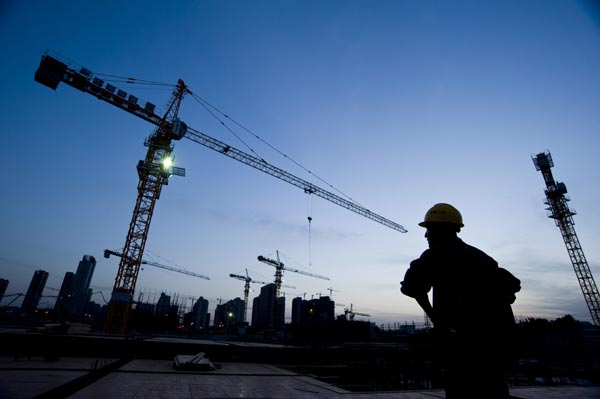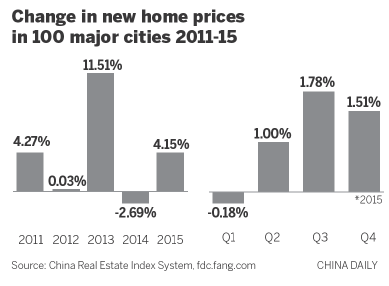 |
|
A residential project is under construction in Huai'an, Jiangsu province. [File Photo/China Daily] |
Smaller areas were less fortunate, experiencing declines in sale prices
If there is one word to summarize China's property market in 2015, it would be "divergence".

Overall sales and prices recovered after a slump in 2014, as average new home prices in 100 cities monitored by China Index Academy, a private research institution, rose 4.15 percent in the past year.
But that belied the fact that only China's largest cities saw higher prices, as losses in smaller cities were offset by strong gains in the largest cities.
Even within large cities, there was significant divergence. Average new home prices in first-tier cities advanced 17.2 percent, but that was largely driven by a spectacular surge in Shenzhen, Guangdong province, where prices swelled 38.7 percent to a record 42,591 yuan ($6,540) per square meter due to short supply of land, a ballooning wealthy class and speculation.
Prices in Shanghai surged 15.3 percent to 36,935 yuan per sq m. In Beijing, prices saw a more modest 9.2 percent increase to 34,981 yuan per sq m.
Second-tier cities as a group saw new home prices decline by 0.53 percent. But performance varied among cities.
Prices in Wuhan, Hubei province, gained 15 percent, the highest among second-tier cities. Central Hefei in Anhui province rose 7.7 percent to reach 7,992 yuan per sq m. Thanks to its proximity to Beijing, prices in Langfang, Hebei province, rose 5.6 percent.
However, Fuzhou, Fujian province, saw prices slump 11 percent, the largest fall in similar cities. Prices in Sanya, Hainan province, contracted 8.4 percent while Dalian in Liaoning province saw prices fall 8 percent.
Prices in most third- and fourth-tier cities fell, with Shaoxing (9.2 percent) and Taizhou (8.3 percent) in Zhejiang province losing the most. Third-tier cities as a group saw a 1.1 percent decline.
The price slump of 2014 continued into 2015, as national prices declined in the first four months of the year, until the effects of favorable policies kicked in, notably allowing second-home buyers who have paid off their mortgage to enjoy the benefits of "first-home buyer" status. Prices began picking up in May, and month-on-month growth was largest in August (up 0.96 percent). Prices in December rose 0.74 percent.
Nationwide, sales surged 20.6 percent on a floor-space basis. Again, first-tier cities led the rebound with a 34 percent surge, while sales in second-tier cities rose 17 percent and third-tier cities climbed 22 percent.
A total of 104 developers sold properties worth more than 10 billion yuan in 2015. In 2014, only 80 did so.
The China Index Academy has a positive outlook for 2016, as the government will roll out more stimulus measures to ease inventory pressures. Of the more than 200 developers surveyed by the academy, 36 percent predicted home prices nationwide would rise within 5 percent. Another 32 percent predicted flat prices.
Fifty-seven percent of developers still feel heavy inventory pressure, but 43 percent feel no or slight pressure. Half of developers plan to raise prices, while 23 percent plan to cut prices.
